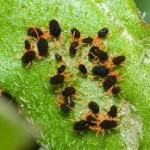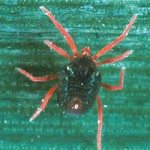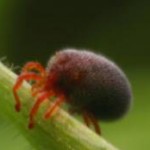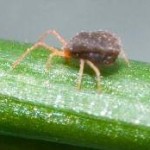Characteristics of earth mite species
- Red legged earth mite Halotydeus destructor (view lifecycle)
- Blue oat mite Penthaleus major (view lifecycle)
- Balaustium mite Balaustium medicagoense (view lifecycle)
- Bryobia mite Bryobia spp. (view lifecycle)
See also: Earth mites in autumn-sown crops and pasture
| Mite species |
Characteristic damage |
Seasonal occurrence |
Other characteristics |
|---|---|---|---|
Red legged earth mite (RLEM)
|
In pastures, majority of damage occurs to clover and medics. |
Active during cool, wet months (May to November). Hatch in autumn from over-summering eggs. Hatching triggered by a significant rainfall event in combination with 7-10 days of mean temperatures below 21ºC. | Over-summering eggs – produced in late spring. RLEM survive in diapause until autumn conditions trigger hatching. |
Blue oat mite (BOM)
|
Penthaleus spp. have specific host preferences:
|
Winter/spring. Hatch in autumn from over-summering eggs | At the end of spring the mites produce thick-walled over-summering eggs that are resistant to dry conditions.
Mites are most easily seen in the late afternoon when they begin feeding on leaves. |
Balaustium mite
|
|
More likely to cause damage in warm, dry seasons. Lower risk of damage in cool, wet seasons. Can overwinter as eggs, but will survive all year round providing there is green plant material and protection from extreme temperatures. Hatching of overwintering eggs occurs when conditions warm and dry spring conditions prevail. | More easily found in warmest part of the day. Often found in southern coastal areas. Less abundant than other mites |
Bryobia mite or clover mite
|
Damages canola, wheat, lupins, clover
|
Survive all year round providing there is green plant material. May not survive cold or very dry conditions unless protected. Overwintering eggs laid in early–mid winter and hatch as conditions warm up | Most active in warm conditions in spring, summer and autumn. Summer rains followed by warm mild autumns give bryobia mites the best conditions for survival and increase. |
Further information
RLEM status and control by Louise Lawrence, CSIRO Entomology – in Australian Grain – 19 – Nov-Dec 2009
Useful links
- Economic considerations for management (Agriculture WA)
- DAF Queensland – mites in field crops
- DEPI Victoria – redlegged earth mite
- Redlegged earth mite—Cesar PestNotes
- Blue oat mite—Cesar PestNotes
- Timerite® model for RLEM—Australian Wool Innovation (AWI)




